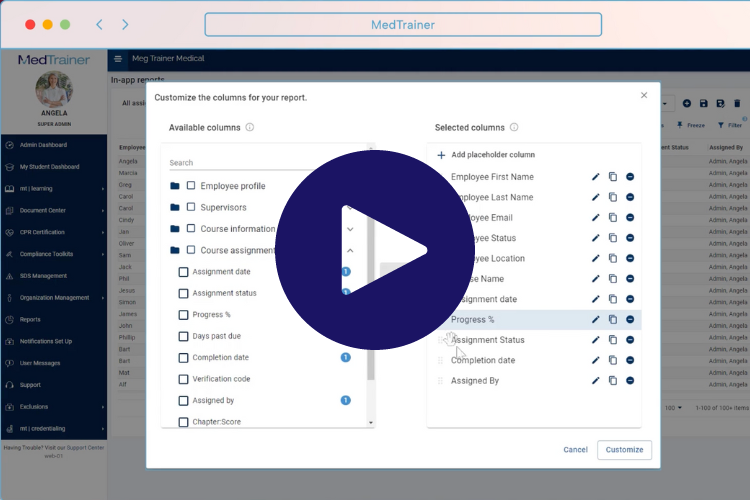Compliance isn’t a concept with a lot of grey area — you’re either compliant with regulations or you’re not! Unfortunately, this yes or no perspective often leads to the misconception that compliance tracking is easy. It’s not. And, in fact, there are times when tracking compliance can be as difficult as meeting the compliance standard itself!
Many healthcare organizations still use old-school methods of compliance tracking: spreadsheets or individual documents that require manual updating. Unfortunately, even the best manual systems aren’t able to keep up with the ever-changing landscape of healthcare compliance standards. It’s why more and more organizations are turning to online compliance reporting software to help simplify things.
Use Compliance Reports You Can’t Live Without to take your reporting to the next level.
What Is Compliance Reporting Software?
As the name implies, healthcare compliance reporting software is specialized software designed to help healthcare organizations adhere to legal and regulatory requirements. It facilitates tracking, monitoring, and reporting of compliance activities, to ensure they meet industry standards set forth by regulatory agencies.
Today, compliance reporting software typically also plays a significant role in automating and streamlining processes related to data collection, analysis, documentation, and reporting. This helps you ensure compliance with various (ever-changing) healthcare regulations, including those posed by:
- Centers for Medicare and Medicaid Services (CMS)
- Health Insurance Portability and Accountability Act (HIPAA)
- Occupational Health and Safety Administration (OSHA)
- Food and Drug Administration (FDA)
- Office of Inspector General (OIG)
- General Data Protection Regulation (GDPR)
- State Medical Boards
In simplest terms, compliance reporting software creates visibility for healthcare organizations, to help them achieve and maintain compliance.
Benefits of Using Software for Compliance Reporting
Compliance reports give you a better understanding of your organization’s overall compliance and credentialing status. Ideally, these reports meet a variety of needs — whether that’s a big-picture overview or comprehensive details for you and leaders to review. This level of organized, detailed information helps the organization know where it stands in terms of compliance.
The best online compliance reporting software is customizable, so you can filter, sort, and save an endless number of reports. Some of the most common compliance reports available through compliance software, such as MedTrainer include:
- Compliance status reports. These reports provide an overview of the organization’s compliance status, highlighting adherence to specific regulations, standards, or policies. They typically include metrics, percentages, or scores indicating the level of compliance achieved.
- Incident reports. These reports document compliance-related incidents, such as data breaches, privacy breaches, security breaches, or instances of non-compliance. They include details of the incident, its impact, and any remedial actions taken.
- Audit reports. Audit reports detail the results of internal or external audits conducted to assess compliance with specific regulations, standards, or internal policies. They outline the scope of the audit, findings, observations, and recommendations for improvement.
- Risk assessment reports. Risk assessment reports identify and assess potential compliance risks within the organization. They evaluate vulnerabilities, threats, and the likelihood and potential impact of non-compliance events.
- Training and education reports. These reports track and document employee training and education activities related to compliance. They indicate which employees have completed specific training programs, their performance, and any required retraining.
- Policy and procedure documentation. Compliance reports may also include documentation of policies, procedures, and guidelines that demonstrate adherence to regulatory requirements.
These reports all come together in a clear picture of compliance. They’re critical for maintaining transparency across the organization.
How to Select Compliance Reporting Software
Compliance reporting software is feature-rich by nature. These platforms typically offer a range of functionalities that facilitate compliance monitoring, reporting, and documentation. However, every platform is different. When it comes to selecting the best tracking and reporting system for your organization, make sure to prioritize these features:
- Compliance tracking. You need the ability to track compliance activities across various regulations and standards. This helps compliance professionals manage and monitor adherence to policies, procedures, and guidelines.
- Documentation management. Look for software that offers a central repository for compliance-related documents. This includes policies, procedures, training materials, and audit reports. Version control, document approval workflows, and document sharing capabilities are all great features!
- Risk assessment and management. Healthcare compliance software needs to incorporate tools for assessing and managing compliance risks. Risk management tools are critical in not only recognizing potential shortcomings, but also remedying them before they create problems.
- Incident reporting and management. Make sure your compliance software has documentation for managing compliance-related incidents, such as privacy breaches, security breaches, or non-compliance events. This may include incident reporting forms, workflows for investigation and resolution, and reporting dashboards.
- Auditing and monitoring. Healthcare compliance reporting software typically includes auditing and monitoring capabilities. Understand how these features can help you conduct internal audits, track compliance performance, and generate reports to demonstrate adherence to regulatory requirements.
- Reporting and analytics. As mentioned above, reports and analytics are crucial in monitoring trends, identifying patterns, and assessing compliance performance. Put your trust in software like MedTrainer, which offers a variety of reports to satisfy regulatory reporting obligations.
- Training and education. A key differentiator when choosing healthcare compliance software is opportunities to track and manage employee training and education. Invest in software that offers features like course management, tracking of training completion, and automated reminders for retraining.
Keep in mind that a variety of other factors also warrant consideration. Consider cybersecurity protocols, the platform’s user interface/user experience (UI/UX), and its ability to integrate with other facets of your compliance program. At the end of the day, your choice in compliance reporting software should make compliance management simpler and more effective!

See the benefits of compliance software in less than 2 minutes.
Should I Use Compliance Reporting Software?
Reporting with MedTrainer is a great way to monitor, manage, and report on detailed information about your organization’s compliance efforts. Above all, it’s a great way to move your organization away from manual compliance tracking and into the modern era of automation!
Interested in learning more about how MedTrainer can help you step up your compliance efforts? Schedule a demo today and get the peace of mind that comes from standardizing and optimizing your approach to compliance management.
